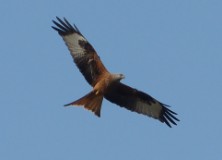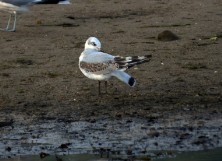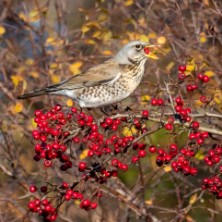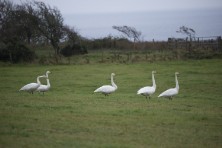October 2021
Bird Sightings



October was much wetter than September with
seventy percent more rain. It was milder and wetter than last October. This
October was the wettest month of the year so far. October is arguably the
busiest birding month, as summer breeders depart, migrants pass through, winter
visitors arrive and there is always a strong chance of something unusual. This
October did not disappoint.
A
particular highlight was a report of six Red Kites in the
Shiskine valley on 5th in the afternoon. There had been a report of one
in Lochranza that morning. In the afternoon a helicopter had been in the Shiskine
valley, which caused some disturbance. These birds may have been feeding on
carrion. The experienced observers had recorded some of the spectacle on their
mobile phone. This is the largest group recorded on Arran. In 2001 birds were
released in Dumfries and Galloway for the first time and that year one was
reported on Arran, the first record since the mid-1800s. In the following years
there have been small numbers of records of single birds. In 2018 there were
twelve records and one of these was of two birds together.
Other
highlights included: a first winter Mediterranean Gull by Fisherman’s Walk on 4th
and 6th, first record since October 2018; a flight of twenty-six
Barnacle Geese passing Kingscross on 15th, again first record since
October 2018; and for the fifth year in a row Little Egret, a colonising
species, was reported, with one at Cordon on 29th.
Winter visitors
included: two Brent Geese and forty-one Rook on Cleats Shore on 5th,
three hundred Greylag Geese also on Cleats Shore on 6th, fourteen
Teal at Carlo on 7th, one Brambling and one Yellowhammer in Sliddery
on 15th, fifty Whooper Swan flying over Lamlash Bay on 17th,
forty Wigeon at Kilpatrick Point on 24th, one Snow Bunting in
Glenkiln on 21st and two Snow Bunting on Goatfell summit on 30th.
While Redwing numbers built up during the month with over eight hundred in
Sliddery on 30th, Fieldfare, in contrast ,had only one report, eight
on Machrie Moor on 21st.
Migration was in full
flow in October as birds were moving out of colder northern Europe to milder
climes. These included: a Sanderling in
Blackwaterfoot on 1st, three hundred and eighty Kittiwake in Loch
Ranza on 3rd, two Wheatear on Sliddery Shore also on 3rd,
fifty Linnet on Cleats Shore on 5th, fifty Goldfinch on Lakin Farm
also on 5th, three hundred Skylark on Cleats Shore on 6th,
seventy Golden Plover in Machrie Bay on 10th, twenty Turnstone at
Dougarie also on 10th, sixty Lesser Redpoll at Catacol on 15th,
sixty Ringed Plover by Fisherman’s Walk on 23rd, a Merlin at
Blackwaterfoot on 24th, eleven Redshank at Sandbraes on 29th
and three hundred and fifty Starling at Sliddery also on 29th.
There
were some “last sightings” of summer visitors also moving south including: a Chiffchaff in Sliddery on 2nd, nine Lesser
Black-backed Gull by Fisherman’s Walk on 4th, seven House Martin in
Kildonan on 13th, sixteen Gannet off Silver Sands on 23rd
and a Swallow in Sliddery on 25th.
Other interesting
records from a month with over one hundred species reported included: a Moorhen at Port na
Lochan on 3rd, a White-tailed Eagle at Imachar on 11th,
two Little Grebe in Loch Ranza on 18th, two Dipper at
Slidderywaterfoot on 23rd, ten Long-tailed Tit in Margnaheglish on
27th, seven Black-throated Diver and ten Great Northern Diver off
Drumadoon Point on 28th, three Goosander at Imachar on 29th
and over one hundred Eider in Lamlash Bay on 31st. This was more
than the island total during the Eider survey in September!
Finally,
my thanks to all the “volunteers” who took part in the Eider survey in late September.
Total number of birds recorded round Arran was forty-five. There was total
coverage of the Arran coastline. Last year the total was seventy-five. In 2019
it was forty-seven. In 2000, it was considerably more, at over six
hundred. The data on the Eider survey
contributes to the ongoing research of Chris Waltho who has been monitoring
Eider in the Clyde Estuary for almost thirty years. The population trend is
down. For the latest report from Chris,
click here:


